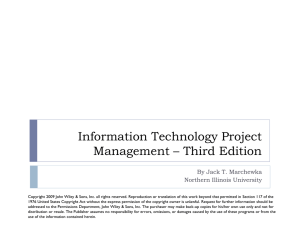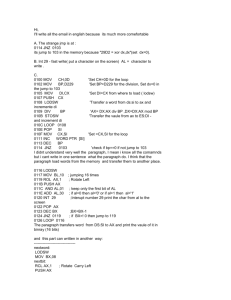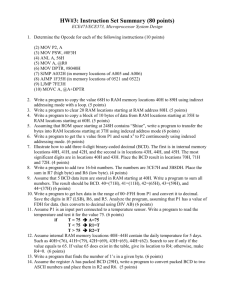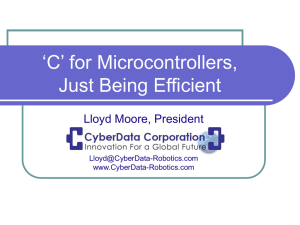design and construction of door locking security system using gsm
advertisement
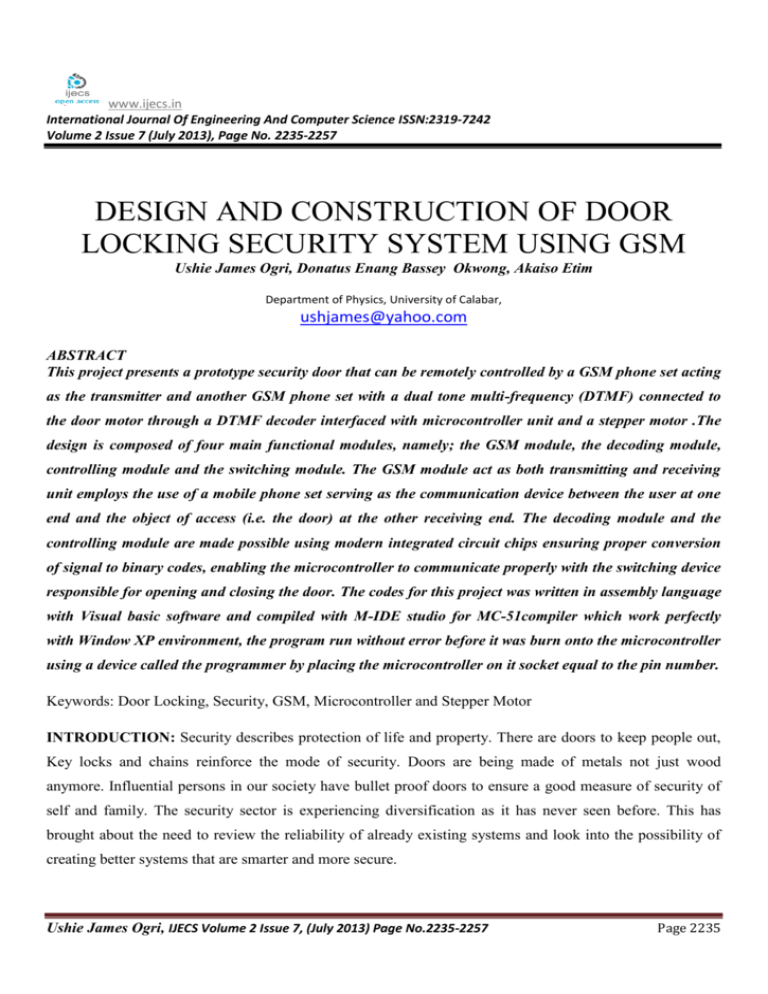
www.ijecs.in International Journal Of Engineering And Computer Science ISSN:2319-7242 Volume 2 Issue 7 (July 2013), Page No. 2235-2257 DESIGN AND CONSTRUCTION OF DOOR LOCKING SECURITY SYSTEM USING GSM Ushie James Ogri, Donatus Enang Bassey Okwong, Akaiso Etim Department of Physics, University of Calabar, ushjames@yahoo.com ABSTRACT This project presents a prototype security door that can be remotely controlled by a GSM phone set acting as the transmitter and another GSM phone set with a dual tone multi-frequency (DTMF) connected to the door motor through a DTMF decoder interfaced with microcontroller unit and a stepper motor .The design is composed of four main functional modules, namely; the GSM module, the decoding module, controlling module and the switching module. The GSM module act as both transmitting and receiving unit employs the use of a mobile phone set serving as the communication device between the user at one end and the object of access (i.e. the door) at the other receiving end. The decoding module and the controlling module are made possible using modern integrated circuit chips ensuring proper conversion of signal to binary codes, enabling the microcontroller to communicate properly with the switching device responsible for opening and closing the door. The codes for this project was written in assembly language with Visual basic software and compiled with M-IDE studio for MC-51compiler which work perfectly with Window XP environment, the program run without error before it was burn onto the microcontroller using a device called the programmer by placing the microcontroller on it socket equal to the pin number. Keywords: Door Locking, Security, GSM, Microcontroller and Stepper Motor INTRODUCTION: Security describes protection of life and property. There are doors to keep people out, Key locks and chains reinforce the mode of security. Doors are being made of metals not just wood anymore. Influential persons in our society have bullet proof doors to ensure a good measure of security of self and family. The security sector is experiencing diversification as it has never seen before. This has brought about the need to review the reliability of already existing systems and look into the possibility of creating better systems that are smarter and more secure. Ushie James Ogri, IJECS Volume 2 Issue 7, (July 2013) Page No.2235-2257 Page 2235 The micro controller based digital lock presented here is an access control system that allows only authorized persons to access a restricted area, this system is best suitable for corporate offices, automated machine (ATMs) and home security. It comprises of a small electronic unit which is in fixed at the entry door to control a solenoid-operated lock with the help of a stepper motor, when an authorized person enters predetermined user password via the global system for mobile communication (GSM) keypad, the stepper motor is operated for a limited time to unlatch the solenoid-operated lock so the door can be open. At the end of preset delay time, the stepper motor is operated in reverse direction and the door gets locked again. When the code has been incorrectly entered three times in a row, the code lock will switch to block mode, this function thwarts any attempt by „hackers‟ to quickly try a large number of codes in a sequence. If the user forgets his password, the code lock can be accessed by a unique 8 digit administrator password and the secret code can be changed any time after entering the current code (Master code). The project intends to interface the microcontroller with the GSM modem and start/stop the engine by sending the predefined messages from the mobile phone to the controlling unit, The software application and the hardware implementation help the microcontroller read the messages sent by the user from a mobile phone or send messages to the mobile phone through the modem and accordingly change the status of the engine motor required. The measure of efficiency is based on how fast the microcontroller can detect the incoming message and act accordingly. The system is totally designed using GSM and embedded systems technology. The Controlling unit has an application program to allow the microcontroller read the incoming data through the modem and control the engine motor as per the requirement. The performance of the design is maintained by the controlling unit. This project uses 8051 microcontroller as the central processing unit. Specifically the proto-type make used of AT89s52 microcontroller with Programs written in assembly language burnt inside the microcontroller to perform the following capabilities; Assembly language is used to write the interfacing program and compiled with M-IDE studio for MC51compiler which work perfectly with Window XP environment and may have compatibility problems with higher versions of the Window operating system In residential applications: solid wood door, panel doors, metal skinned wood-edged doors and metal edgewrapped doors (www.wikipedia.org, 2008). In addition to doors are; deadbolts, frame reinforcements, door chains and hinge screws – long 3” screws (www.statefarm.com, 2012) but despite these reinforcements door, security by itself is very porous. An electronics or electric lock is a locking device which operates by means of electric current (Gibson Stan, 2001). One of such locks is magnetic locked (mag locked). A large electro-magnet is mounted on the door frame and a corresponding armature is held fast to the magnet (Mckenice, 1995). mag locks by design fail unlocked, that is if power is removed they unlock. Ushie James Ogri, IJECS Volume 2 Issue 7, (July 2013) Page No.2235-2257 Page 2236 SYSTEM DESIGN: The design of a door locking security system using GSM is a complex design which comprises of so many modules (parts) brought together to form the overall design. Each of these modules is made up of discrete components that are joined together to achieve a particular purpose. These separate modules are: The Power Supply Unit, The Buzzer Unit, The micro controller Unit, Telephone unit and Switching. These different units cannot function alone, they all need to function together to achieve the desired result. The GSM modem received tone from the GSM network as shown by the direction of the arrow in the diagram below and transmit same to the DTMF decoder but the current value was very small (i.e. about 0.1mA) it was step-up by the tone transformer so that it could be decode by the DTMF decoder which then send the decoded codes to the microcontroller for processing and outputting to relevant component to act accordingly. The block diagram of the design showing all the units combined together are shown in the figure below. GSM MODERM BUZZE R DOOR MOTOR RELAYS RELAY DRIVER ULN 2003 MICROCONTROLLE R 8051 (AT89S52) DTMF DECODER (MT8870) Fig: 3 LCD POWER SUPPLY UNIT Fig. 3.2 Block Diagram of GSM Enable Door Lock. Ushie James Ogri, IJECS Volume 2 Issue 7, (July 2013) Page No.2235-2257 Page 2237 SOFTWARE PROGRAMS FOR THE MICROCONTROLLER: Microcontroller is a programmable device (Mazidi, 1997). It is an intelligent core for a specialised dedicated system (Sanchez & Canton, 2007). The firmware part deals with programming the microcontroller so that it can control the operation of the IC‟s used in the hardware implementation. In the research, M-IDE studio for MC-51 software development tool is used to compile the source code, which was written in assembly language. The Universal programmer was used to burn the compile source code onto the microcontroller. Software development involves a series of steps which are necessary for the development of reliable and maintainable software. SYSTEM FLOW CHART: A flow chart showing in detail the working of thee device is shown below. From this flow chart, we can see how the different unit come together to achieve the desired purpose. Start Establish link with receiver phone Enter access codes Is password correct? YES Grant access 8sec delay NO Is N ≥ 3 error count NO YES Activate Alarm Close Door Fig 3.10: System Flow Chart WRITING OF THE PROJECT SOURCE CODE: This is codes that machine understand which enable all the component units in the circuit to communicate with each other. the codes for this project was written Ushie James Ogri, IJECS Volume 2 Issue 7, (July 2013) StopPage No.2235-2257 Page 2238 in assembly language with Visual basic software and compiled with M-IDE studio for MC-51compiler which work perfectly with Window XP environment, the program run without error before it was burn onto the microcontroller using a device called the programmer by placing the microcontroller on it socket equal to the pin number of the microcontroller. The source code is at appendix. RESULTS AND DISCUSSION: The prototype door security system developed in this project did well in achieving its original goals. In the beginning the system will boot up with display on the LCD screen prompting the user to enter pin code. The password door lock system has a default password of “198526”, 196310 and the user is given only 3 attempts to enter the correct password. If not, the keypad will switch to block mode requesting for PUK number which is “38893982” eight numbers. At the same time an alarm will sound until the PUK number is imputed with correct PIN. The development of this technology for the field of security system is not only possible, but it could even prove to be very useful. SUMMARY AND WORKING PROCEDURE OF THE PROJECT: The operation of this project is summarized as follow; i. A call is placed to the phone that is connected to the system, this call is like any normal call to a friend, colleague etc. the call made is set to be automatically answered at the other (i.e. door) end, the caller immediately presses six digits numbers (password). ii. The signal qualities of the tones are first increased by passing it into a step up transformer, the output of which goes to the DTMF decoder. iii. In the DTMF decoder the tones are received and decoded into a binary code equivalent, the output of the decoder is sent to the microcontroller. iv. The microcontroller‟s internal programming processes the output from the DTMF decoder. Here, these decoded signals are identified as the keys pressed on the phone keypad. the microcontroller output these information into three unit; Liquid crystal display unit, to show the user the digit pressed. The ULN2003 driver. this converts the logic level from the microcontroller‟s TTL to the signal that control the switching sequence of the relay The Buzzer alarm. This sound to alert the user when a digit is pressed and also sound continuously when wrong numbers are entered by intruder. On entry of the six digit code the “#” button of the keypad is pressed as confirmation of the code. If the code entered is correct, (if the user mistakenly typed wrong digit, this can be delete by pressing “0” key to backspace) data is sent to the microcontroller to activate door opening sequence; this sequence includes the display of an “Access Granted” text on the LCD screen and Ushie James Ogri, IJECS Volume 2 Issue 7, (July 2013) Page No.2235-2257 Page 2239 the output of a signal to the transistor driving the relay. This signal causes the relay contacts to switch and completes the motor circuit thereby causing the door to open. The door closes automatically after precisely 8 seconds, but user can close the door by pressing the “#” key on the keypad. The microcontroller is programmed to recognized this character and bring about the switching action of another relay which closes the door. Table 4.1 Component Description and Prices COMPONENT DESCRIPTION UNIT PRICE (N) QUANTITY MICROCONTROLLER(AT89S52) TONE TRANSFORMER 240/12v 16X2 LCD SCREEN 1200 1 1200 500 1 500 2000 1 2000 DTMF DECODER 3000 1 3000 3.75445MHZ CRYSTAL OSCILLATOR 100 2 200 30pF CAPACITOR 50 4 200 10µF,16v CAPACITOR 100 1 100 12v/500mA TRANSFORMER 500 1 500 BRIDGE RECTIFY 300 2 600 1000µf,25v CAPACITOR 200 2 200 LM7805 REGULATOR 150 1 150 10K POTENTIOMETER 100 1 100 RESISTOR 20 5 100 12V/500mA TRANSFORMER 500 1 500 VERIO BAORD 200 1 200 SOLDERING IRON 300 1 300 SOLDERING LEAD 500 1 500 150pF CAPACITOR 100 1 100 Ushie James Ogri, IJECS Volume 2 Issue 7, (July 2013) Page No.2235-2257 TOTAL PRICE (N) Page 2240 I.C SOCKET 50 3 150 GSM MODEM 7000 1 7000 12V/10A RELAY 200 2 400 ULN2003 RELAY DRIVER 300 1 300 7000 1 7000 PROGRAMMING LOGISTICS 15000 - 15000 TRANSPORTATION AND MISCELENOUS 10000 - 10000 15v/2000mA TRANSFORMER 500 2 1000 EAR PIECE,13A PLUG & CONNECTORS 1400 1 1400 GRAND TOTAL - - 52,000 DOOR FABRICATION AND SERVO MOTOR CONCLUSION The work was successful. It is evidence that the use of mobile phones with the right circuitry can be used to operate a security system, since the mobile phone in today‟s world; it is an access device a lot easier and affordable to obtain as opposed to specially fabricated keys and smart-cards. The ability of the system to accesses a secure place (Home, office, ATM etc.) remotely almost anywhere in the world is a plus since technology has made the world a global village. REFRENCES AT89s52 datasheet, www.atmel.com, (13 December, 2012). Bill Bowden, “controlling Relay with logic signals” http//ourworld.compuserve.com, (10 September, 2008). Crystal Oscillator, http://en.wikipedia.org (10th September 2011). Door Hinges and security, http://www.statefarm.com/learningbsafeathmburghing.asp (20th February, 2008). Electric locks, http://en.wikipedia.org/wiki/door security, (10th November, 2012). Gibson Stan (2001) “the illustrated Dictionary of electronics”, McGraw-Hill Publication, USA. Horowitz, Paul; Winfield, H. (1995) “The Art of Electronics”, Cambridge University Press, London. Mckenice Smith Ian, Hughes (1995) “Electrical technology” 7th edition, Longman group ltd New York. MT8070D1 datasheet, www.mitel.com (11th November, 2011). Ushie James Ogri, IJECS Volume 2 Issue 7, (July 2013) Page No.2235-2257 Page 2241 Muhammad Ali Mazidi, Janice Gillispie, Mazidi Rolin and D. McKinlayn (1997) “The 8051 Microcontroller and Embedded Systems Using Assembly and C” 2nd Edition, Dept. of Computer Science and Information Engineering, National Cheng Kung University, TAIWAN. Sanchez Julio and Canton Maria (2007), “Microcontroller programming- the micro chip PIC”, CRC Press USA. APPENDIX A: PROJECT SOURCE CODE org 00h ; reset vector address Data_Ram_0 data 30 Data_Ram_1 data Data_Ram_0 + 1 Data_Ram_2 data Data_Ram_1 + 1 Data_Ram_3 data Data_Ram_2 + 1 Data_Ram_4 data Data_Ram_3 + 1 Data_Ram_5 data Data_Ram_4 + 1 Data_Ram_6 data Data_Ram_5 + 1 Data_Ram_7 data Data_Ram_6 + 1 Data_Ram_8 data Data_Ram_7 + 1 Data_Ram_9 data Data_Ram_8 + 1 receive_bit equ P1.0 DTMF_receive_bitQA equ P1.4 DTMF_receive_bitQB equ P1.3 DTMF_receive_bitQC equ P1.2 DTMF_receive_bitQD equ P1.1 data_bank data 20 rs bit p2.7 rw bit p2.6 en bit p2.5 sdata data p3 ADC_Data data p1 ADC_clock bit p0.4 relaya bit p2.0 relayb bit p2.1 buzzer bit p0.2 bank data 49 clr relaya Ushie James Ogri, IJECS Volume 2 Issue 7, (July 2013) Page No.2235-2257 Page 2242 clr relayb clr buzzer mov r0 , #Data_Ram_9 hat1: mov @r0 , #' ' dec r0 cjne r0 , #Data_Ram_0 -1 , hat1 clr relaya clr relayb clr buzzer mov r7 , #0 setb rw clr en setb en lcall clear_lcd lcall init_lcd lcall clear_lcd clr rs mov sdata,#80h+00h setb en clr en lcall wait_lcd mov Dptr,#message1 Repeat_Data_processingxx : call wait loop212: clr a movc a , @a+Dptr inc Dptr cjne a,#'@' , jaj212 clr rs MOV SDATA,#80H+40H SETB EN CLR EN LCALL WAIT_LCD jmp Repeat_Data_processingxx jaj213w: call write_text jmp Repeat_Data_processingxx jaj212 :cjne a,#'#' , jaj213w call wait call wait call wait call wait setb rw clr en setb en lcall clear_lcd lcall init_lcd lcall clear_lcd clr rs mov sdata,#80h+00h setb en clr en lcall wait_lcd Ushie James Ogri, IJECS Volume 2 Issue 7, (July 2013) Page No.2235-2257 Page 2243 mov Dptr,#message2 Repeat_Data_processingxx11 : call wait loop2121: clr a movc a , @a+Dptr inc Dptr jaj213: cjne a,#'@' , jaj21211n clr rs MOV SDATA,#80H+40H SETB EN CLR EN LCALL WAIT_LCD jmp Repeat_Data_processingxx11 jaj21211n:cjne a,#'#' , jaj213z call wait call wait call wait call wait setb rw clr en setb en lcall clear_lcd lcall init_lcd lcall clear_lcd clr rs mov sdata,#80h+00h setb en clr en lcall wait_lcd mov Dptr,#message3 jmp james jaj213z : call write_text jmp Repeat_Data_processingxx11 james : call wait loop2121c: clr a movc a , @a+Dptr inc Dptr cjne a,#'#' , jaj21211nc CALL prompting sjmp start_validation jaj21211nc: call write_text sjmp james start_validation : jnb receive_bit , $ setb buzzer call DTMF_DECODER_READER2 call wait clr buzzer jb receive_bit , $ jmp start_validation wait_lcd: Ushie James Ogri, IJECS Volume 2 Issue 7, (July 2013) Page No.2235-2257 Page 2244 clr en ; rt lcd command clr rs ;it's a command setb rw ;it's a read command mov sdata,#0ffh ;set all pins to ff initially setb en ;clock out command to lcd mov a,sdata ;read the return value jb acc.7,wait_lcd ;if bit 7 high, lcd still busy clr en ;finish the command clr rw ;turn off rw for future commands ret init_lcd: clr rs mov sdata,#38h setb en clr en lcall wait_lcd clr rs mov sdata,#0eh setb en clr en lcall wait_lcd clr rs mov sdata,#06h setb en clr en lcall wait_lcd ret clear_lcd: clr rs mov sdata,#01h setb en clr en lcall wait_lcd ret write_text: setb rs mov sdata,a setb en clr en lcall wait_lcd ret waitx: TT0c: MOV R3,#8 MOV R2,#8 MOV R1,#236 TT1c: DJNZ R1,TT1c DJNZ R2,TT1c DJNZ R3,TT1c RET Ushie James Ogri, IJECS Volume 2 Issue 7, (July 2013) Page No.2235-2257 Page 2245 ret DTMF_DECODER_READER2: ;scanning for button one 1==0001 jnb DTMF_receive_bitQA ,ExitSubB0 jb DTMF_receive_bitQB ,ExitSubB0 jb DTMF_receive_bitQC ,ExitSubB0 jb DTMF_receive_bitQD ,ExitSubB0 mov a , #'*' call write_text mov data_bank, #'1' CALL SHIFT_DATA ret ExitSubB0:;scanning for button two 2==0010 jb DTMF_receive_bitQA ,ExitSubBB jnb DTMF_receive_bitQB ,ExitSubBB jb DTMF_receive_bitQC ,ExitSubBB jb DTMF_receive_bitQD ,ExitSubBB mov a , #'*' call write_text mov data_bank, #'2' CALL SHIFT_DATA ;call play2 ret ;;;;;;;;;;;;;;;;;;; ExitSubBB:;scanning for button THREE 3==0011 jNb DTMF_receive_bitQA ,ExitSubBC jNb DTMF_receive_bitQB ,ExitSubBC jb DTMF_receive_bitQC ,ExitSubBC jb DTMF_receive_bitQD ,ExitSubBC mov a , #'*' call write_text mov data_bank, #'3' CALL SHIFT_DATA ret ExitSubBC: ;;;;;;;;;;;;;;;; ;scanning for button four 4==0100 jb DTMF_receive_bitQA ,ExitSu jb DTMF_receive_bitQB ,ExitSu jnb DTMF_receive_bitQC ,ExitSu jb DTMF_receive_bitQD ,ExitSu mov a , #'*' call write_text mov data_bank , #'4' CALL SHIFT_DATA ret ;;; ExitSu:;scanning for button five 5==0101 jNb DTMF_receive_bitQA ,ExitSu1 jb DTMF_receive_bitQB ,ExitSu1 jnb DTMF_receive_bitQC ,ExitSu1 Ushie James Ogri, IJECS Volume 2 Issue 7, (July 2013) Page No.2235-2257 Page 2246 jb DTMF_receive_bitQD ,ExitSu1 mov a , #'*' call write_text mov data_bank, #'5' CALL SHIFT_DATA ret ;;;;%%%%%%%%%%%%%%%%%%%%%%%% ExitSu1:;scanning for button six 6==0110 jb DTMF_receive_bitQA ,Exit jNb DTMF_receive_bitQB ,Exit jnb DTMF_receive_bitQC ,Exit jb DTMF_receive_bitQD ,Exit mov a , #'*' call write_text mov data_bank, #'6' CALL SHIFT_DATA ret Exit:;scanning for button7==0111 jNb DTMF_receive_bitQA ,Exit1 jNb DTMF_receive_bitQB ,Exit1 jNb DTMF_receive_bitQC ,Exit1 jb DTMF_receive_bitQD ,Exit1 mov a , #'*' call write_text mov data_bank, #'7' CALL SHIFT_DATA ret Exit1:;scanning for button8==1000 jb DTMF_receive_bitQA ,ExitX jb DTMF_receive_bitQB ,ExitX jb DTMF_receive_bitQC ,ExitX jNb DTMF_receive_bitQD ,ExitX mov a , #'*' call write_text mov data_bank, #'8' CALL SHIFT_DATA ret ExitX:;scanning for button9==1001 jNb DTMF_receive_bitQA ,ExitA1 jb DTMF_receive_bitQB ,ExitA1 jb DTMF_receive_bitQC ,ExitA1 jNb DTMF_receive_bitQD ,ExitA1 mov a , #'*' call write_text mov data_bank, #'9' CALL SHIFT_DATA ret ExitA1:;scanning for button*==1011 jNb DTMF_receive_bitQA ,ExitXX1 jNb DTMF_receive_bitQB ,ExitXX1 jb DTMF_receive_bitQC ,ExitXX1 Ushie James Ogri, IJECS Volume 2 Issue 7, (July 2013) Page No.2235-2257 Page 2247 jNb DTMF_receive_bitQD ,ExitXX1 call delete_data_process ret ;;;&&&&&&&&&&&&&&&&&&& ExitXX1:;scanning for button0==1010 jb DTMF_receive_bitQA ,ExitXXX1 jNb DTMF_receive_bitQB ,ExitXXX1 jb DTMF_receive_bitQC ,ExitXXX1 jNb DTMF_receive_bitQD ,ExitXXX1 call delete_data_process ret ExitXXX1:;scanning for button#==1100 jb DTMF_receive_bitQA ,ExitXXXX1_error jb DTMF_receive_bitQB ,ExitXXXX1_error jNb DTMF_receive_bitQC ,ExitXXXX1_error jNb DTMF_receive_bitQD ,ExitXXXX1_error call verify ret ExitXXXX1_error : ret SHIFT_DATA: mov Data_Ram_9 ,Data_Ram_8 mov Data_Ram_8 ,Data_Ram_7 mov Data_Ram_7 ,Data_Ram_6 mov Data_Ram_6 ,Data_Ram_5 mov Data_Ram_5 ,Data_Ram_4 mov Data_Ram_4 ,Data_Ram_3 mov Data_Ram_3 ,Data_Ram_2 mov Data_Ram_2,Data_Ram_1 mov Data_Ram_1 ,Data_Ram_0 mov Data_Ram_0 ,data_bank ret verify: mov r0 ,#Data_Ram_9 ;password_1 : db '198526#' ;password_2 : db '196310#' cjne @r0 ,#' ' , next mov a , @r0 dec r0 cjne @r0 ,#' ' , next mov a , @r0 dec r0 cjne @r0 ,#' ' , next mov a , @r0 dec r0 cjne @r0 ,#' ' , next mov a , @r0 dec r0 cjne @r0 ,#'2' , next Ushie James Ogri, IJECS Volume 2 Issue 7, (July 2013) Page No.2235-2257 Page 2248 mov a , @r0 dec r0 cjne @r0 ,#'9' , next mov a , @r0 dec r0 cjne @r0 ,#'6' , next mov a , @r0 dec r0 cjne @r0 ,#'3' , next mov a , @r0 call write_text dec r0 cjne @r0 ,#'2' , next mov a , @r0 call write_text dec r0 cjne @r0 ,#'6' , next mov a , @r0 call write_text dec r0 call open ret ;password_1 : db '198526#' next: mov r0 ,#Data_Ram_9 cjne @r0 ,#' ' , next1 mov a , @r0 call write_text dec r0 cjne @r0 ,#' ' , next1 mov a , @r0 call write_text dec r0 cjne @r0 ,#' ' , next1 mov a , @r0 call write_text dec r0 cjne @r0 ,#' ' , next1 mov a , @r0 call write_text dec r0 cjne @r0 ,#'2' , next1 dec r0 cjne @r0 ,#'9' , next1 dec r0 cjne @r0 ,#'8' , next1 dec r0 cjne @r0 ,#'5' , next1 dec r0 cjne @r0 ,#'2' , next1 dec r0 cjne @r0 ,#'6' , next1 Ushie James Ogri, IJECS Volume 2 Issue 7, (July 2013) Page No.2235-2257 Page 2249 dec r0 call open ret next1: inc r7 cjne r7 , #3 , MAM1 jmp sat mam1: jmp mam sat: CALL PUK mov r7 , #0 mov DPTR , #unlock call ogba Repeat_Data_processingxx41 : loop2124: clr a movc a , @a+Dptr inc Dptr cjne a,#'@' , jaj2124 clr rs MOV SDATA,#80H+40H SETB EN CLR EN LCALL WAIT_LCD jmp Repeat_Data_processingxx41 jaj213w4: call write_text jmp Repeat_Data_processingxx41 jaj2124 :cjne a,#'#' , jaj213w4 mov r0 ,#Data_Ram_0 nextg : mov @r0 , #' ' inc r0 cjne r0 ,#Data_Ram_9 + 1 , nextg gagg: jnb receive_bit , $ ExitXXX1a:;scanning for button#==1100 jb DTMF_receive_bitQA ,ExitXXXX1_errora jb DTMF_receive_bitQB ,ExitXXXX1_errora jNb DTMF_receive_bitQC ,ExitXXXX1_errora jNb DTMF_receive_bitQD ,ExitXXXX1_errora ; 34493941 mov r0 ,#Data_Ram_9 cjne @r0 ,#' ' , nextl2 dec r0 cjne @r0 ,#' ' , nextl2 dec r0 cjne @r0 ,#'3' , nextl2 dec r0 cjne @r0 ,#'8' , nextl2 dec r0 cjne @r0 ,#'8' , nextl2 dec r0 cjne @r0 ,#'9' , nextl2 Ushie James Ogri, IJECS Volume 2 Issue 7, (July 2013) Page No.2235-2257 Page 2250 dec r0 cjne @r0 ,#'3' , nextl2 dec r0 cjne @r0 ,#'9' , nextl2 dec r0 cjne @r0 ,#'8' , nextl2 dec r0 cjne @r0 ,#'2' , nextl2 dec r0 clr buzzer mov r0 ,#Data_Ram_0 nextgz: mov @r0 , #' ' inc r0 cjne r0 ,#Data_Ram_9 + 1 , nextgz call prompting ret nextl2:mov r0 ,#Data_Ram_9 nextgd : mov @r0 , #' ' dec r0 cjne r0 ,#Data_Ram_0 - 1 , nextgd ExitXXXX1_errora : call DTMF_DECODER_READER2 jb receive_bit , $ jmp gagg MAM: call errorr mov r0 , #Data_Ram_9 nextgdc: mov @r0 , #' ' dec r0 cjne r0 ,#Data_Ram_0 - 1 , nextgdc call wait call wait call wait RET OPEN: setb rw clr en setb en lcall clear_lcd lcall init_lcd lcall clear_lcd clr rs mov sdata,#80h+00h setb en clr en lcall wait_lcd mov r0 , #Data_Ram_9 nextgdca: mov @r0 , #' ' dec r0 cjne r0 ,#Data_Ram_0 - 1 , nextgdca clr buzzer MOV DPTR , #access Ushie James Ogri, IJECS Volume 2 Issue 7, (July 2013) Page No.2235-2257 Page 2251 AGAIN: Repeat_Data_processingxxn: loop212J: clr a movc a , @a+Dptr inc Dptr cjne a,#'@' , jaj212J clr rs MOV SDATA,#80H+40H SETB EN CLR EN LCALL WAIT_LCD jmp again jaj213e:call write_text jmp Repeat_Data_processingxxn jaj212j :cjne a,#'#' , jaj213e SETB relaya clr relayb call waitx call waitx call waitx call waitx call waitx call waitx clr relayb clr relaya call waitx call waitx call waitx call waitx setb rw SETB relayb clr relaya call waitx call waitx call waitx call waitx call waitx call waitx call waitx call waitx clr relayb clr relaya call waitx call waitx SETB relayb clr relaya call waitx call waitx clr relayb clr relaya Ushie James Ogri, IJECS Volume 2 Issue 7, (July 2013) Page No.2235-2257 Page 2252 call waitx SETB relayb clr relaya call waitx call waitx clr relayb clr relaya call waitx call prompting ret errorr: setb rw clr en setb en lcall clear_lcd lcall init_lcd lcall clear_lcd clr rs mov sdata,#80h+00h setb en clr en lcall wait_lcd MOV DPTR , #error AGAINv: Repeat_Data_processingxxv: loop212Jv: clr a movc a , @a+Dptr inc Dptr cjne a,#'@' , jaj212Jv clr rs MOV SDATA,#80H+40H SETB EN CLR EN LCALL WAIT_LCD jmp againv jaj213ek:call write_text jmp Repeat_Data_processingxxv jaj212jv :cjne a,#'#' , jaj213ek call prompting ret puk: setb rw clr en setb en lcall clear_lcd lcall init_lcd lcall clear_lcd Ushie James Ogri, IJECS Volume 2 Issue 7, (July 2013) Page No.2235-2257 Page 2253 clr rs mov sdata,#80h+00h setb en clr en lcall wait_lcd MOV DPTR , #prompt_PUK AGAINv1: Repeat_Data_processingxxv1: loop212Jv1: clr a movc a , @a+Dptr inc Dptr cjne a,#'@' , jaj212Jv1 clr rs MOV SDATA,#80H+40H SETB EN CLR EN LCALL WAIT_LCD jmp againv1 jaj213ek1:call write_text jmp Repeat_Data_processingxxv1 jaj212jv1 :cjne a,#'#' , jaj213ek1 ret verify2: mov DPTR ,#password_1 ; loading pointer data mov r0 ,#Data_Ram_0 Quit_verification1 : loop212q: clr a movc a , @a+Dptr inc Dptr cjne @r0 ,#12, Quit_verification1 inc r0 inc r7 cjne r7, #7 , Quit_verification1 mov r7, #00000000b ; reset counter Quit_verification: mov DPTR ,#password_2 ; loading pointer data mov r0 ,#Data_Ram_0 Repeat_Data_processingxxd : Quit_verification1d : loop212qd: clr a movc a , @a+Dptr inc Dptr cjne @r0,#78, Quit_verificationda inc r0 inc r7 cjne r7, #7 , Quit_verification1d mov r7 , #00000000b ; reset counter Quit_verificationda: inc r6 cjne r6 , #3 , error_counter mov r6, #00000000b ; reset counter Ushie James Ogri, IJECS Volume 2 Issue 7, (July 2013) Page No.2235-2257 Page 2254 error_counter: ret delete_data_process: mov r0 , #Data_Ram_0 CONTINUE_LOADING : mov @r0 , #' ' inc r0 cjne r0 , #Data_Ram_9 + 1 , CONTINUE_LOADING CALL prompting ret prompting: setb rw clr en setb en lcall clear_lcd lcall init_lcd lcall clear_lcd clr rs mov sdata,#80h+00h setb en clr en lcall wait_lcd mov Dptr,#prompt Repeat_Data_processingxx22 : jmp mov loop21222: clr a movc a , @a+Dptr inc Dptr cjne a,#'@' , jaj21222f clr rs MOV SDATA,#80H+40H SETB EN CLR EN LCALL WAIT_LCD jmp Repeat_Data_processingxx22 jaj213zz: call write_text Repeat_Data_processingxx22 jaj21222f :cjne a,#'#' , jaj213zz mov a , #'[' call write_text MOV SDATA,#80H+4fH SETB EN CLR EN LCALL WAIT_LCD a , #']' call write_text MOV SDATA,#80H+49H SETB EN CLR EN LCALL WAIT_LCD Ushie James Ogri, IJECS Volume 2 Issue 7, (July 2013) Page No.2235-2257 Page 2255 ret ret wait:; TT0112: MOV R3,#3 MOV R2,#208 MOV R1,#41 TT1112: DJNZ R1,TT1112 DJNZ R2,TT1112 DJNZ R3,TT1112 RET ogba: call wait call wait call wait call wait setb rw clr en setb en lcall clear_lcd lcall init_lcd lcall clear_lcd clr rs mov sdata,#80h+00h setb en clr en lcall wait_lcd ret message1: db 'GSM enabled DOOR@ lock#' message2: db ' Designed BY @OKWONG , AKAISO#' message3: db 'Mat NO:06/45094#' password_1 : db '198526#' password_2 : db '196310#' access: db ' Access Granted@ Door Open#' error: db ' Access Denied@ Invalid code#' prompt: db 'Security Door@Pin code#' prompt_PUK: db 'Enter PUK pin#' unlock: db '**Unlock system*@***************#' PUK_number: db '38893981#' end APPENDIX B: PROJECT GALLERY Ushie James Ogri, IJECS Volume 2 Issue 7, (July 2013) Page No.2235-2257 Page 2256 Exterior view of controlling unit Side view of the whole system Door sliding to show the motor with circuitry Interior view of the controlling unit Front view of the whole system Sliding door in closed position Ushie James Ogri, IJECS Volume 2 Issue 7, (July 2013) Page No.2235-2257 Page 2257



